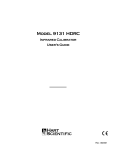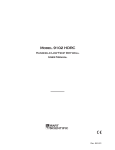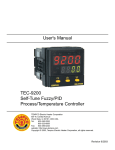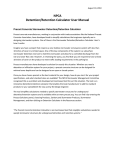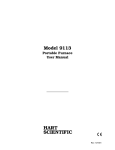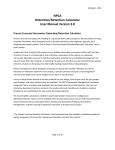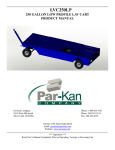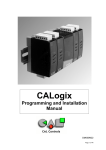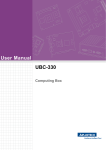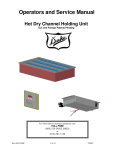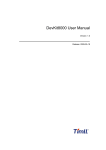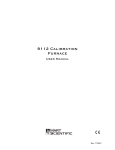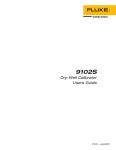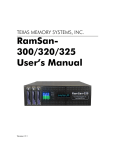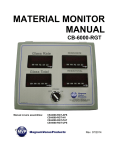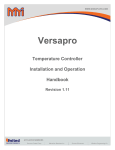Download Model9100HDRC - Fluke Russia
Transcript
Model 9100 HDRC Handheld Dry-well User Manual Rev. 8A1601 © Copyright,1997 Hart Scientific, Inc. 799 E. Utah Valley Drive American Fork, Utah 84003-9775 Telephone (801) 763-1600 • Fax (801) 763-1010 Internet: http://www.hartscientific.com WARNING To ensure the safety of operating personnel, and to avoid damage to this equipment: DO NOT operate this unit without a properly grounded, properly polarized power cord. DO NOT connect this unit to a non-grounded, non-polarized outlet. DO USE a ground fault interrupt device. WARNING To ensure the safety of personnel, and to avoid damage to equipment: DO NOT use this unit for any application other than calibration work. DO NOT use this unit in environments other than those listed in the user’s manual. Continous use of this equipment at high temperatures for extended periods of time requires caution. Completely unattended high temperature operation is not recommended for safety reasons. Components and heater lifetimes can be shortened by continuous high temperature operation. Follow all safety guidelines listed in the user’s manual. WARNING CALIBRATION EQUIPMENT SHOULD ONLY BE USED BY TRAINED PERSONNEL. c d Table of Contents 1 Introduction. . . . . . . . . . . . . . . . . . . . . . 1 2 Specifications and Environmental Conditions . . . 3 2.1 2.2 2.3 Specifications . . . . . . . . . . . . . . . . . . . . . . . 3 Environmental Conditions . . . . . . . . . . . . . . . . 3 Warranty . . . . . . . . . . . . . . . . . . . . . . . . . 4 3 Safety Guidelines . . . . . . . . . . . . . . . . . . 5 4 Quick Start . . . . . . . . . . . . . . . . . . . . . . 7 4.1 4.2 4.3 5 Parts and Controls . . . . . . . . . . . . . . . . . . 9 5.1 5.2 5.3 6 Set-up . . . . . . . . . . . . . . . . . . . . . . . . . . 13 Setting the Temperature . . . . . . . . . . . . . . . . . 13 Controller Operation . . . . . . . . . . . . . . . . 15 7.1 7.2 7.3 8 Rear Panel . . . . . . . . . . . . . . . . . . . . . . . . 9 Prop View . . . . . . . . . . . . . . . . . . . . . . . . 10 Front Panel . . . . . . . . . . . . . . . . . . . . . . . 11 General Operation . . . . . . . . . . . . . . . . . 13 6.1 6.2 7 Unpacking . . . . . . . . . . . . . . . . . . . . . . . . 7 Set-up. . . . . . . . . . . . . . . . . . . . . . . . . . . 7 Power . . . . . . . . . . . . . . . . . . . . . . . . . . . 7 Programming . . . . . . . . . . . . . . . . . . . . . . 15 Locking/Unlocking the Controller . . . . . . . . . . . . 15 Switching display units . . . . . . . . . . . . . . . . . 15 Test Probe Calibration . . . . . . . . . . . . . . . 19 8.1 Calibration Methods . . . . . . . . . . . . . . . . . . . 19 8.1.1 8.1.2 8.1.3 8.2 Dry-Well Characteristics . . . . . . . . . . . . . . . . . 20 8.2.1 8.2.2 9 Direct Calibration . . . . . . . . . . . . . . . . . . . . . . . . 19 Comparison Calibration . . . . . . . . . . . . . . . . . . . . . 19 Calibration of Multiple Probes. . . . . . . . . . . . . . . . . . 20 Vertical Gradient . . . . . . . . . . . . . . . . . . . . . . . . 20 Stabilization and Accuracy . . . . . . . . . . . . . . . . . . . 20 Calibration Procedure . . . . . . . . . . . . . . . 23 9.1 9.2 Pre-Calibration . . . . . . . . . . . . . . . . . . . . . 23 Calibration . . . . . . . . . . . . . . . . . . . . . . . . 23 9.2.1 9.2.2 9.2.3 Span Adjust . . . . . . . . . . . . . . . . . . . . . . . . . . . 23 Zero Adjust . . . . . . . . . . . . . . . . . . . . . . . . . . . 23 Accuracy Check . . . . . . . . . . . . . . . . . . . . . . . . 24 v 10 Maintenance . . . . . . . . . . . . . . . . . . . . 25 11 Troubleshooting . . . . . . . . . . . . . . . . . . 27 11.1 Troubleshooting. . . . . . . . . . . . . . . . . . . . . 27 11.2 CE Comments . . . . . . . . . . . . . . . . . . . . . . 28 11.2.1 EMC Directive. . . . . . . . . . . . . . . . . . . . . . . . . . 28 11.2.2 Low Voltage Directive (Safety) . . . . . . . . . . . . . . . . . 28 11.3 Wiring Diagram . . . . . . . . . . . . . . . . . . . . . 29 vi 1 Introduction 1 Introduction Hart Scientific’s Model 9100 HDRC Dry-well Calibrator is a small, portable instrument designed for quick on-site checks and calibration of thermocouple and RTD temperature probes. It features an aluminum temperature block well. Three different blocks are available. Block “A” has six holes, four that accept probe diameters of 1/4", 5/32", 1/8", and 1/16", and two that accept probes of 3/16" diameter to allow comparison calibrations. Block “B” has four holes that accept probe diameters of 3/8", 1/4", 3/16" and 1/8". Block “C” has two holes that accept probe diameters of 3/16" and 1/2". See Figure 1 on page 3. The instrument is controlled by a microprocessor based digital PID temperature controller and uses a precision platinum RTD as a sensor with a heater to control the well temperature. The controller display will show the well temperature and also the set-point temperature. The temperature may be set to any temperature within the range of the instrument in 0.1 degree increments by using the three buttons on the control panel. The calibrator’s multiple fault protection devices insure user and instrument safety and protection. The 9100 dry-well calibrator was designed for portability, speed, and ease of operation. It’s use will provide a means of quick, accurate calibration and comparisons of temperature sensors and other devices. 9100 Manual Rev. 8A1601 1 2 Specifications and Environmental Conditions 2 2.1 Specifications and Environmental Conditions Specifications Operating Range 33°C to 300°C (92°F to 572°F) Accuracy 33 to 100°C: ±0.5°C 100 to 300°C: ±1°C holes greater than 0.25": ±2°C Stability ±0.2°C Heating Times 35 to 300°C: 9.5 min. Stabilization 3 min. Cooling Times 300 to 100°C: 14 min. Holes (probe sizes) See Figure 1 Block A:Sized to fit these diameters: 1/16", 1/8", 5/32", 1/4" and two at 3/16" Block B: 1/8", 3/16", 1/4", and 3/8" Block C: 1/2" and 3/16" Depth 4" (1/16" hole is 3.5") Power 115 VAC (±10%), 50/60 Hz or 230 VAC (±10%), 50/60 Hz, 1.5 amps max. Size 2.25" H x 4.9" W x 5.9"D (57 mm x 125 mm x 150 mm) Weight 2 lb. 3 oz. (1.08 Kg) Block “A” Block “B” Block “C” 1/4" 1/8" 5/32" 3/8" 3/16" 1/2" 3/16" 3/16" 3/16" 1/16" 1/8" 1/4" Figure 1 Block design options for the 9100 2.2 Environmental Conditions Although the instrument has been designed for optimum durability and trouble-free operation, it must be handled with care. The instrument should not be operated in an excessively dusty or dirty environment. Maintenance and cleaning recommendations can be found in the Maintenance Section of this manual. The instrument operates safely under the following conditions: • temperature range: 5–40°C (41–104°F) • ambient relative humidity: 15–50% 9100 Manual Rev. 8A1601 3 2 Specifications and Environmental Conditions • pressure: 75kPa–106kPa • mains voltage within ±10% of nominal • vibrations in the calibration environment should be minimized • altitude does not effect the performance or safety of the unit 2.3 Warranty Hart Scientific, Inc. (Hart) warrants this product to be free from defects in material and workmanship under normal use and service for a period as stated in our current product catalog from the date of shipment. This warranty extends only to the original purchaser and shall not apply to any product which, in Hart’s sole opinion, has been subject to misuse, alteration, abuse or abnormal conditions of operation or handling. Software is warranted to operate in accordance with its programmed instructions on appropriate Hart products. It is not warranted to be error free. Hart’s obligation under this warranty is limited to repair or replacement of a product which is returned to Hart within the warranty period and is determined, upon examination by Hart, to be defective. If Hart determines that the defect or malfunction has been caused by misuse, alteration, abuse or abnormal conditions or operation or handling, Hart will repair the product and bill the purchaser for the reasonable cost of repair. To exercise this warranty, the purchaser must forward the product after calling or writing Hart for authorization. Hart assumes NO risk for in-transit damage. For service or assistance, please contact the manufacturer. Hart Scientific, Inc. 799 East Utah Valley Drive American Fork, UT 84003-9775 Phone: (801) 763-1600 Fax: (801) 763-1010 E-mail: [email protected] THE FOREGOING WARRANTY IS PURCHASER’S SOLE AND EXCLUSIVE REMEDY AND IS IN LIEU OF ALL OTHER WARRANTIES, EXPRESS OR IMPLIED, INCLUDING BUT NOT LIMITED TO ANY IMPLIED WARRANTY OR MERCHANTABILITY, OR FITNESS FOR ANY PARTICULAR PURPOSE OR USE. HART SHALL NOT BE LIABLE FOR ANY SPECIAL, INDIRECT, INCIDENTAL, OR CONSEQUENTIAL DAMAGES OR LOSS WHETHER IN CONTRACT, TORT, OR OTHERWISE. 4 Manual Rev. 8A1601 Hart Scientific 3 Safety Guidelines 3 Safety Guidelines • Operate the instrument in room temperatures between 5–40°C (41–104°F). Allow sufficient air circulation by leaving at least 6 inches of space between the instrument and nearby objects. Overhead clearance needs to allow for safe and easy insertion and removal of probes for calibration. • The dry-well is a precision instrument. Although it has been designed for optimum durability and trouble free operation, it must be handled with care. The instrument should not be operated in excessively wet, oily, dusty, or dirty environments. It is important to keep the well of the instrument clean and clear of any foreign matter. DO NOT operate near flammable materials. • DO NOT use fluids to clean out the wells. • The instrument can generate extreme temperatures. Precautions must be taken to prevent personal injury or damage to objects. Probes may be extremely hot when removed from the instrument. Cautiously handle probes to prevent personal injury. Carefully place probes on a heat resistant surface or rack until they are at room temperature. Never place any objects other than the probe to be calibrated into the well. • Use only a grounded AC mains supply of the appropriate voltage to power the instrument. The dry-well requires 1.5 amps at 115 VAC (±10%), 50/60 Hz and 0.75 amps at 230 VAC (±10%) 50/60 Hz. • Before initial use, after transport, and anytime the dry-well has not been energized for more than 10 days, the instrument needs to be energized for a “dry-out” period of 1-2 hours before it can be assumed to meet all of the safety requirements of the IEC 1010-1. • If a mains supply power fluctuation occurs, immediately turn off the instru- ment. Power bumps from brown-outs and black-outs could damage the instrument. Wait until the power has stabilized before re-energizing the instrument. • The calibrator is equipped with an internal thermal fuse and an electrical fuse. If a fuse blows, it is likely caused by failure of another part. If this occurs, the calibrator should be returned to the factory for inspection. 9100 Manual Rev. 8A1601 5 4 Quick Start 4 4.1 Quick Start Unpacking Unpack the dry-well carefully and inspect it for any damage that may have occurred during shipment. If there is shipping damage, notify the carrier immediately. Verify that the following components are present: • 9100 Dry-well • Power Cord • Manual 4.2 Set-up Place the calibrator on a flat surface with at least 6 inches of free space around the instrument. The prop may be swung down to raise the front of the instrument from a horizontal position. Plug the power cord into a grounded mains outlet. Observe that the nominal voltage corresponds to that indicated on the back of the calibrator. Turn on the power to the calibrator by toggling the power switch on. The fan should begin quietly blowing air through the instrument and the controller display should illuminate after 3 seconds. After a brief self-test the controller should begin normal operation. If the unit fails to operate please check the power connection. The display will begin to show the well temperature and the well heater will start operating to bring the temperature of the well to the set-point temperature. 4.3 Power Plug the dry-well power cord into a mains outlet of the proper voltage, frequency, and current capability. Typically this will be 115 VAC (±10%), 50/60 Hz or 230 VAC (±10%), 50/60 Hz. Turn the dry-well on using the switch on the rear panel. The dry-well will turn on and begin to heat to the previously programmed temperature set-point. The front panel LED display will indicate the actual dry-well temperature. 9100 Manual Rev. 8A1601 7 5 Parts and Controls 5 Parts and Controls The user should become familiar with the dry-well calibrator and its parts: (See Figures 2, 3, and 4). 5.1 Rear Panel Power Cord - The removable power cord, (Figure 2) attaches to the back side of the 9100. It plugs into a standard 115 VAC (optional 230 VAC) grounded socket. Power Switch - The power switch is located on the back panel of the calibrator. The switch is either on or off. The on position is for normal operation. The off position disconnects power to the entire unit. Fan - A fan inside the calibrator runs continuously when the unit is being operated. This provides cooling to the instrument. Allow 6 inches of open space in front and behind the calibrator to allow adequate ventilation. Fan American Fork Utah 84003 Made In U.S.A. Power Switch 115 V 50/60 Hz 1.5 Amp Max. Electronics Fuse Internal Serial No: 4A001 Power Cord Figure 2. Rear Panel 9100 Manual Rev. 8A1601 9 5 Parts and Controls Figure 3. Side view of the 9100 showing the prop 5.2 Prop View Prop - The prop (Figure 3) is located on the bottom side of the 9100. It lays flat against the bottom of the calibrator when not in use. It can be swung down into a standing position when using the instrument at an inclined position. The prop was not designed to be used as a handle for carrying the instrument. To avoid damage, it should not be forced beyond the inclined position of the calibrator. 10 Manual Rev. 8A1601 Hart Scientific 5 Parts and Controls 5.3 Front Panel Well Block - Located on the right side of the front panel (while facing the front of the 9100) is the well opening where a block (Figure 1 on page 3) designed to accept different probe sizes is installed. Each block is designed to accept different diameter temperature sensors. Three different blocks are available. Block “A” has six holes, four that accept probe diameters of 1/4", 5/32", 1/8", and 1/16", and two that accept probes of 3/16" diameter to allow comparison calibrations. Block “B” has four holes that accept probe diameters of 3/8", 1/4", 3/16" and 1/8". Block “C” has two holes that accept probe diameters of 3/16" and 1/2". Surrounding the well opening are small ventilation holes which provide cooling to the instrument. Controller Display - The numeric LED display shows the process temperature or the actual temperature of the well from 0.0 to 300.0°C. (0.0 to 572.0°F.) The display shows the set-point temperature when the ✱ button is pressed. Located in the upper left of the temperature display is the main set-point (SP1) LED. This is the cycle indicator and shows the on/off state of the block heater. Controller Buttons - The three buttons on the controller allow for adjustment of the set-point temperature. When pressed, the button marked ✱ toggles the display from the actual block temperature to the set-point temperature with the units of measure being used (°C or °F). While holding the ✱ button, the set-point temperature can be changed by pressing and holding in either the button marked ▲ or ▼ until the desired set-point is reached. The longer the keys are held down, the faster the set-point will change. When the desired set-point temperature is reached, releasing ✱ button immediately changes the display back to the actual block temperature and the controller begins to heat or cool to the new set-point temperature. 9100 HDRC Figure 4. Front Panel 9100 Manual Rev. 8A1601 11 6 General Operation 6 6.1 General Operation Set-up Place the calibrator on a flat surface with at least 6 inches of free space in front of and behind the instrument. The prop may be swung down to raise the front of the instrument from a horizontal position. Plug the power cord into an AC grounded outlet of the appropriate voltage. The well must be clear of any foreign objects before probes are inserted. Turn on the power to the calibrator by toggling the switch at the rear of the instrument to the on position. The controller display should illuminate and after a few seconds the fan should begin blowing air through the instrument. If the unit fails to operate check the power connection. When the calibrator is first powered on all of the LED segments will temporarily illuminate as the controller performs a brief self-test and set-up. The display will then begin to show the actual block temperature and the well heater will begin operating to bring the temperature of the well to the set-point temperature. 6.2 Setting the Temperature The dry-well calibrator may be set to any temperature between 0.0 and 300.0°C in 0.1°C increments. To set the temperature, simply press and hold the ✱ key and the appropriate ▲ or ▼ button until the desired temperature is attained. Pressing the ✱ button changes the numeric display to show the set-point temperature and activates the ▲ and ▼ keys. Note that the longer the ▲ or ▼ keys are held down, the faster the set-point will change. When the desired set-point temperature is reached, release the ▲ or ▼ and the ✱ buttons. The panel will resume display of the actual block temperature. If the set-point temperature is changed the controller will cause the unit to heat or cool to the desired set-point temperature. The cycle indicator LED will pulse on and off indicating the duty cycle of the heater. The display will indicate the actual block temperature which continuously changes until it reaches the set-point temperature. A small overshoot in the block temperature is typical as it stabilizes to the set-point temperature. Three to five minutes is normally required for the block to reach the set-point temperature if the set-point is adjusted to a higher value. It may take a little longer if the set-point is adjusted to the outer temperature limits. 9100 Manual Rev. 8A1601 13 7 Controller Operation 7 Controller Operation The controller is fully programmable. Each of the parameters such as proportional band, integration time, display units, and calibration offset can be viewed and altered. The controller has been configured at the factory for optimum accuracy, stability, and response time. These parameters should not be changed although the user is free to do so if desired. The following section explains how the controller is programmed and particularly how to switch the parameter units from the factory settings. 7.1 Programming The controller is shipped from the factory with a software lock on all programmable parameters. This prevents accidental accessing and changing of the pre-set parameters. The 9100 parameters can be browsed and read without unlocking the software lock mentioned above. (See Figure 5.) Programming the controller and accessing the parameter settings is done using the three controller keys just below the display. The program menu is entered and exited by pressing the ▲ and ▼ buttons at the same time for three seconds. After three seconds the controller will enter level 1 of its menu. The display will toggle between tunE and oFF. From this point in the control menu, the ▲ and ▼ buttons can be used to step up or down through the parameters of level 1. To access another level of the controller, press the ▼ button to step through the controller parameters to the bottom of level 1 until the display toggles between LEUL and 1. From this point the other 2 levels are accessed by pressing and holding in the ✱ button and pressing the ▲ button to step to levels 2 or 3. Each of the 3 levels can be stepped through in the same way using the ▲ or ▼ button. 7.2 Locking/Unlocking the Controller In order to change any parameter, the controller will have to be unlocked. The lock/unlock parameter is accessed by going into level 3 as explained above. Once inside level 3 (see Figure 5), step up until the Uer and 2 is toggling on the display. Now press and hold the ▲ and ▼ buttons simultaneously for 10 seconds. The LoCK and ALL should now be alternating on the display (see Figure 6). Press the ✱ button and step down using the ▼ button until nonE appears in the display. Holding down the ▲ and ▼ buttons for 3 seconds from this point will unlock all controller parameters and settings and return the controller display to show the block temperature. 7.3 Switching display units The calibrator is set at the factory to display in °C or °F. At some point the user may want to change units from °C to °F or from °F to °C. The unit change is a simple one that can be used as an example of changing any of the variables or parameters within the program menu. After unlocking the controller as described above, press the ▲ and ▼ buttons for 3 seconds. This accesses level 1 of the menu. 9100 Manual Rev. 8A1601 15 16 Manual Rev. 8A1601 S T A R T Move up and down in a level with the ∆ and ∇ buttons. Press and hold the ∆ and ∇ buttons for 3 seconds to enter the program mode. 199.3 Program Entry Point LEUL 1 off * * Move up and down levels with the and ∆ and and ∇ buttons. LEUL 3 55d rLY uP.SC (See separate chart for Level 4) Access to hidden Level 4. Press and hold the ∆ and ∇ buttons for 10 seconds. Read SP1 output device SP1.d 2 2 Read SP2 output device Burn-out protection SP2.d burn oFF 100 100 Note: Values shown are factory default values with the exception of the grayed out parameters and values. These settings vary according to the unit calibration and can be found on the unit certification sheet. LEUL SP1.P Select Autotune or Park Read SP1 output power % (Not adjustable) SP1 manual power control % Set SP1 power limit % Set SP2 power limit % Ir.2d PL.2 rEU.d 8 tune der.t In.2n Selet output modes Direct/Reverse rEU.L Fshi SP2.A 2.0 hAnd Derivative time/Rate daC Select SP1/2 LED modes 0 0 SPAn Sensor span adjust Zero sensor error oFF none 2Ero UAr° Read monitor results Select control accuracy monitor Ct A 2.2 nonE Main SP2 operating mode: Alarms/Cool strategy 0.1° ChEk rEAd Read Autotune tuning data Software Version Functions Reset SP2.b Select display resolution 300.0 0.0 dAta UEr rSEt Value 5.0 30 Derivative approach control CyC.t diSP Set full scale Set scale minimum rtd °C Value Display Alternates Subsidiary SP2 mode: Alarm (latch sequence) 0.0 hi.SC band Proportional cycle-time or ON/OFF oFSt oFF Lo.SC PL.1 Offset/Manual reset SP.LY 325.0 1.2 Lock main setpoint SP1 Set.2 Select input sensor inPt 2.0 Integral time/Reset Adjust SP2 setpoint bnd.2 unit on.of Proportional band/Gain or Hysteresis Select SP2 Hysteresis or Prop Band CYC.2 Select °C/°F or Process units Parameter Display Alternates Value int.t Select SP2 ON/OFF or cycle-time Parameter Display Alternates Parameter 7 Controller Operation Figure 5. Controller Programming Chart Hart Scientific 7 Controller Operation Display Alternates Parameter Move up and down in a level with the ∆ and ∇ buttons. Value dEr.5 Derivative sensitivity 0.5 di5.5 Display sensitivity 25 no.AL Disable SP2 Alarm annunciator on oFF ProG Program mode auto-exit switch Auto StAY LocK Program security lock none LEU.3 LEUL 4 LEU.2 ALL Return to Level 3 only Move down a level or change options with the and ∆ and and ∇ buttons. * * Level 4 Entry Point (Level 3 Version Parameter) UEr Lock Options Press and hold the ∆ and ∇ buttons for 10 seconds to enter the hidden level 4 menu. LEU.3 Locks levels 3 and 4 only LEU.2 Locks levels 2, 3, and 4 only ALL none Locks all functions No functions or options locked Figure 6. Controller Level 4 (Parameter Lock Options) Programming Chart 9100 Manual Rev. 8A1601 17 7 Controller Operation Once inside level 1, the other levels of the menu may be accessed. After looking at the menu chart (Figure 5), the user can see that the unit parameter is changed within level 2. Press the ▼ button to get to the bottom of level 1 where the LEUL and 1 are shown alternating in the display. Press and hold the ✱ button and press the ▲ button until the 2 shows on the display. Now inside level 2, use the ▲ and ▼ buttons to find the unit parameter. Notice how the display flashes between unit and ° C. Press and hold the ✱ button and press the ▼ button until ° F shows on the display. After the buttons are released, the display should be flashing unit and ° F instead of unit and ° C. The change has been made. To return to the temperature display either press and hold the ▲ and ▼ buttons for 3 seconds or wait approximately 1 minute and the controller will automatically return. This is how all of the adjustable parameters for the controller work on the 9100 HDRC Calibrator. The controller may be locked again after changing parameters to avoid accidentally changing one of them. Follow the instructions above and replace the nOnE at the LoCK menu with ALL and then exit out of the program menu as explained. 18 Manual Rev. 8A1601 Hart Scientific 8 Test Probe Calibration 8 Test Probe Calibration For optimum accuracy and stability, allow the calibrator to warm up for 10 minutes after power-up and then allow adequate stabilization time after reaching the set-point temperature. After completing calibration, allow the block to cool before switching the power off. 8.1 8.1.1 Calibration Methods Direct Calibration Direct calibration involves testing a probe directly against the dry-well’s temperature display. The advantage of this method is that it is quick and easy. Insert the probe to be calibrated into the well of the dry-well calibrator. The probe should fit snugly into the calibrator well yet should not be so tight that it cannot be easily removed. Avoid any dirt or grit that may cause the probe to jam into the well. Best results are obtained with the probe inserted to the full depth of the well. Once the probe is inserted into the well, allow adequate stabilization time to allow the test probe temperature to settle as described. Once the probe has settled to the temperature of the well, it may be compared to the calibrator display temperature. The display temperature should be stable to within 0.1°C for best results. Never introduce any foreign material into the wells. Fluids, etc., can leak into the calibrator causing damage to the calibrator or binding and damage to your probe. 8.1.2 Comparison Calibration Comparison calibration involves testing a probe against a similar reference probe. The advantage to this method is that better accuracy can be achieved since errors due to dry-well inaccuracy, stem effect, and drift can be reduced. After inserting the probes to be calibrated, allow sufficient time for the probes to settle and the temperature of the dry-well to stabilize. It is best if both the reference probe and the probe under test are the same size and construction. Using probes with different lengths, diameters and materials will have different stem effects causing an unknown temperature difference. All dry-wells have horizontal and vertical gradients that change with temperature . This is an unknown variable which can be factored out if probes are the same type, length, diameter, and material. Probes should be inserted to the same depth in the well. The following procedure can be used to calibrate a probe against a reference while eliminating error due to temperature gradients between wells. • Place the reference probe in one well. • Place the probe to be calibrated, the unit under test (UUT), in another well. • With the reference inserted into one well and the probe under test inserted into a second well, make measurements of each. 9100 Manual Rev. 8A1601 19 8 Test Probe Calibration • Swap the locations of the reference probe and probe under test. Allow plenty of time for thermal settling. • Make another set of measurements of the reference probe and the probe under test. • Average the two measurements of the reference probe. Average the two measurements of the probe under test. Averaging the two measurements in this way eliminates error due to temperature gradients between the two wells. • You may now compare the averaged measurement of the probe under test with the averaged measurement of the reference probe. • For best results repeat the test several times at the same temperature and at different temperatures. This method can be used with different types of probes but the user must determine the uncertainty of the measurement. 8.1.3 Calibration of Multiple Probes Fully loading the calibrator with probes increases the time required for the temperature to stabilize after inserting the probes. Be sure that the temperature has stabilized before starting the calibration. Multiple probes may be calibrated simultaneously using either the direct or comparison calibration method. Stem effect will cause less error in the comparison calibration method than with the direct calibration method. 8.2 Dry-Well Characteristics Understanding the thermal characteristics of the dry-well calibrator can help you achieve the best accuracy and efficiency possible. 8.2.1 Vertical Gradient There is a temperature gradient vertically in the test well. The heater has been applied to the block in such a way as to compensate for nominal heat losses out of the top of the dry-well and minimize vertical temperature gradients. However, actual heat losses will vary depending on the number and types of probes inserted into the calibrator and the block temperature. For best results, insert probes the full depth of the well. 8.2.2 Stabilization and Accuracy The stabilization time of the dry-well calibrator will depend on the conditions and temperatures involved. Typically, the dry-well will be stable to 0.2°C within three minutes of reaching the set-point temperature as indicated by the display. Ultimate stability will be achieved 10 to 15 minutes after reaching the set temperature. Inserting a cold probe into a well will require another period of stabilization depending on the magnitude of the disturbance and the required accuracy. For example, inserting a ¼ inch diameter probe at room temperature into a sleeve 20 Manual Rev. 8A1601 Hart Scientific 8 Test Probe Calibration at 300°C will take approximately 5 minutes to be within 0.1°C of its set-point and will take 10 minutes to achieve maximum stability. Decreasing the time required for the calibration process can be accomplished by knowing how soon to make the measurement. It is recommended that typical measurements be made at the desired temperatures with the desired test probes to establish these times. 9100 Manual Rev. 8A1601 21 9 Calibration Procedure 9 9.1 Calibration Procedure Pre-Calibration Make sure all parameters in the controller are set according to the parameter table provided in the operation manual. a) Turn the unit on. b) Set all parameters to the values shown in the chart. 9.2 Calibration Accuracy Specification: ± 0.5°C for 30 to 100°C ±1.0°C for 100 to 300°C 9.2.1 Span Adjust 1. Record the current span value (spancur) 2. Set the controller to 50°C (Slow). Allow the dry-well to stabilize (about 15 minutes) after reaching the set temperature. 3. Record the actual temperature of the dry-well at 50°C. (Tlow) 4. Set the controller to 300°C (Shigh). Allow the dry-well to stabilize (about 15 minutes) after reaching the set temperature. 5. Record the actual temperature of the dry-well at 300°C. (Thigh) 6. The new span value is calculated by the following formula: errorhigh − errorlow span = 300 Thigh − Tlow + span cur where errorhigh is Thigh–Shigh and errorlow is Tlow–Slow . 7. 9.2.2 Record and set the new span parameter. Zero Adjust Note: New temperature measurements must be taken. You cannot use the values from span adjust. 9100 1. Record the current zero value (zerocur). 2. Set the controller to 50°C (Slow). Allow the dry-well to stabilize (about 15 minutes) after reaching the set temperature. 3. Record the actual temperature of the dry-well at 50°C. (Tlow) Manual Rev. 8A1601 23 9 Calibration Procedure 4. Set the controller to 300°C (Shigh). Allow the dry-well to stabilize (about 15 minutes) after reaching the set temperature. 5. Record the actual temperature of the dry-well at 300°C. (Thigh) 6. Calculate the “zero” parameter by averaging the error values: errorlow + errorhigh zero = 2 + zero cur where errorhigh is Thigh–Shigh and errorlow is Tlow–Slow . 7. 9.2.3 Record and set the zero parameter. Accuracy Check Set the controller to 50°C. Allow about 15 minutes for stabilization after reaching the set-point temperature. Record the actual temperature of the dry-well. Repeat for set-points of 100°C, 150°C, 200°C, 250°C and 300°C. If any of the measured temperatures are not within specification, repeat the Span Adjust and the Zero Adjust section of the procedure as needed. 24 Manual Rev. 8A1601 Hart Scientific 10 Maintenance 10 Maintenance • The calibration instrument has been designed with the utmost care. Ease of operation and simplicity of maintenance have been a central theme in the product development. Therefore, with proper care the instrument should require very little maintenance. Avoid operating the instrument in an oily, wet, dirty, or dusty environment. • If the outside of the instrument becomes soiled, it may be wiped clean with a damp cloth and mild detergent. DO NOT use harsh chemicals on the surface which may damage the paint. • It is important to keep the well of the calibrator clean and clear of any for- eign matter. DO NOT use fluid to clean out the well. • The dry-well calibrator should be handled with care. Avoid knocking, bumping, or dropping the calibrator. Due to the size and portability of the 9100, it is vulnerable to being shocked and dropped as it is carried around. It may be easily dragged off from a counter top while in use. This action will not only cause damage to the instrument, but may damage probes that are inserted at the time. Never string probe cables or the power cord across an isle where people could trip over them and pull the calibrator from its place. DO NOT place objects on top of the calibrator or apply excessive pressure to the chassis. With a little care, this calibrator will provide long-lasting, trouble-free operation. • DO NOT slam the probe stems into the well. This type of action can cause a shock to the sensor. • If a hazardous material is spilt on or inside the equipment, the user is re- sponsible for taking the appropriate decontamination steps as outlined by the national safety council with respect to the material. • If the mains supply cord becomes damaged, replace it with a cord with the appropriate gauge wire for the current of the instrument. If there are any questions, call Hart Scientific Customer Service for more information. • Before using any cleaning or decontamination method except those rec- ommended by Hart, users should check with Hart Scientific Customer Service to be sure that the proposed method will not damage the equipment. • If the instrument is used in a manner not in accordance with the equipment design, the operation of the dry-well may be impaired or safety hazards may arise. • The 9100 calibrator is programmed and calibrated at the factory for opti- mum performance. Field adjustment to the program should not be necessary. If the unit is suspected to be out of calibration or in need of repair, please contact the factory for assistance. The unit should be recalibrated at the factory yearly. Never attempt to modify the unit or alter the programmed constants. • Warning: Never introduce any fluids or other foreign material into the well block. This will damage the calibrator and may cause sticking and damage to your probes. In the event that the calibrator should require service or repair, please contact the manufacturer for assistance. The user should not attempt to make any repairs or adjustments. 9100 Manual Rev. 8A1601 25 11 Troubleshooting 11 Troubleshooting If problems arise while operating the 9100, this section provides some suggestions that may help you solve the problem. A wiring diagram is also included. Opening the unit without contacting Hart Scientific Customer Service may void the warranty. 11.1 Troubleshooting Below are several situations that may arise followed by suggested actions for fixing the problem. Controller changes are indicated in the Controller Operation section of this manual. Refer to this section and , refer to Figure 5 and Figure 6 for the specific programming path. Refer to the Report of Calibration for any unique controller values. Incorrect Temperature Reading • Check the sensor span adjust “SPAn” in Level 2 to see that it is set cor- rectly. • Check the zero sensor error “2Er 0” in Level 2 to see that it is set correctly. • Check input sensor “inPt” in Level 2 is set to “rtd”. If not, master reset the controller. (See Controller lock-up for master reset instructions. The display is off after waiting 30 seconds • Check that the power cord is plugged in. • If the unit has power and the display is off, the fuse may be blown and the unit needs to be returned to Hart Scientific for repair. Contact Hart Scientific Customer Service. The display flashes “Input Fail” • There is a sensor error. Contact Hart Scientific Customer Service. The display flashes “Input None” • Contact Hart Scientific Customer Service. Unit will not heat to 300°C • The ambient temperature is too low. User cannot set the temperature to the maximum or minimum values of the unit • Check to see that “hi.SC” in Level 2 is set to 300 • Check to see that “Lo.SC” in Level 2 is set to 0.0 Controller lock-up • Do a master reset of the controller in Level 3 by setting “rSEt” to “ALL”. The controller transfers to Level 5 where the following parameters must be reentered. InPt - rtd 9100 Manual Rev. 8A1601 27 11 Troubleshooting Unit - ° C Sp1.D - rLy • Re-enter Level 1, 2, and 3, parameters. Refer to Figure 5, Figure 6, and the Report of Calibration for Level 1, Level 2, and Level 3 values. Temperature readout is not the actual temperature of the well • With the unit stable, slowly rotate the unit. If no change occurs, the unit may need to be calibrated. Contact Hart Scientific Customer Service. If the display changes more than twice the normal display deviation, another unit in the area could be emitting therefore energy. Move the unit to a different location and rotate the unit again. If the temperature is correct in this new area or deviates differently than the first area, therefore energy is present in the room. If you have to perform the test in the effected area, use the comparison test to eliminate any possible errors. 11.2 CE Comments 11.2.1 EMC Directive Hart Scientific’s equipment has been tested to meet the European Electromagnetic Compatibility Directive (EMC Directive, 89/336/EEC). Selection o fLight Industrial or Heavy Industrial compliance has been based on the intended use of the instrument. Units designed for use in a calibration laboratory have been tested to Light Industrial Standards. Units designed to be used in the “field” have been tested to both Light Industrial and Heavy Industrial Standards. The Declaration of Conformity for your instrument lists the specific standards to which the unit was tested. For units used in the “field”, a slight degradation of accuracy may be noticed between 300–350 MHz with a field intensity of 10V/M at the unit. A piece of equipment in proximity to the unit under test must emit greater than 1000 times the permissible CE standard (EN55022) at these specific frequencies to have any effect on the unit. Units used in a laboratory are not effected. See the Troubleshooting Section above. 11.2.2 Low Voltage Directive (Safety) In order to comply with the European Low Voltage Directive (73/23/EEC), Hart Scientific equipment has been designed to meet the IEC 1010-1 (EN 61010-1) and IEC 1010-2-010 (EN 61010-2-010) standards. 28 Manual Rev. 8A1601 Hart Scientific 9100 LINE GND 18-22AWG GRN/YEL BRN 18-22AWG BLU 18-22AWG AC LINE Manual Rev. 8A1601 2 1 FAN + J4 - 2 PWR J1 1 1 J2 POWER BOARD BLU 18-22AWG BRN 18-22AWG POWER SWITCH 2 HEATER WHT/RED/BLK 2 1 J5 2 1 J3 BLK DRYWELL BLOCK HEATER SENSOR GRY VIO WHT/RED/BLK WHT 0.22UF 1 + 2 - 3 + 4 - 5 6 7 8 RTD/PT100 SSR DRIVE BY KJ 9100-4 APPROVAL 8-18-97 APPROVAL KJ RELEASE ENGINEER DESIGN CHECKED DRAWN DATE CONTRACT NO. FULL 64841 DATE 8-18-97 SHEET 1OF B021-2S17 DWG NO. 1 A REV. AMERICAN FORK, UTAH 799 EAST UTAH VALLEY DR. (801)763-1600 9100 DRYWELL WIRING FSCM NO. SCALE: SIZE HART SCIENTIFIC NOTES: 1. ALL WIRES ARE 20AWG UNLESS OTHERWISE SPECIFIED. RELAY SWITCH 12 VDC TEMPERATURE CONTROLLER REVISIONS UPDATE WIRING DIAGRAM DESCRIPTION 11.3 NEUTRAL A LTR. 11 Troubleshooting Wiring Diagram Figure 7 Wiring Diagram 29




























